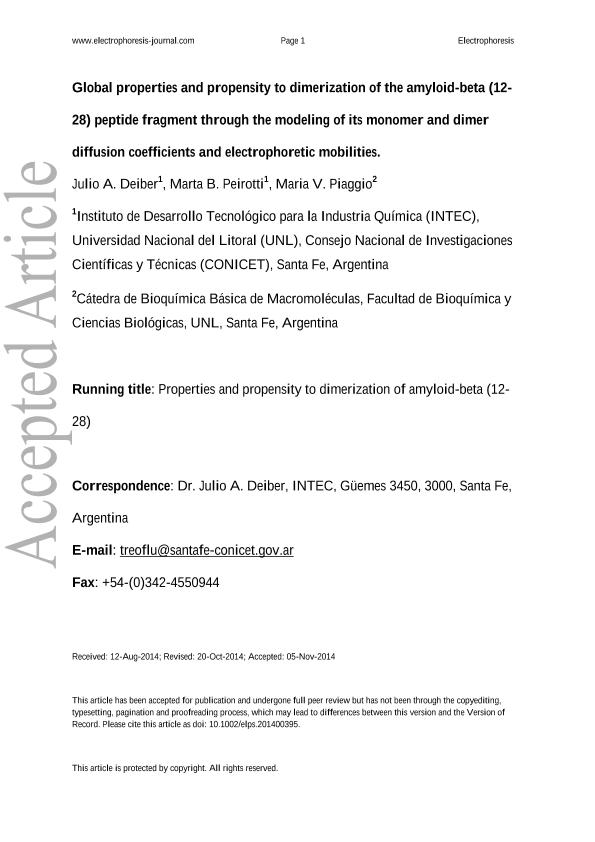Mostrar el registro sencillo del ítem
dc.contributor.author
Deiber, Julio Alcides

dc.contributor.author
Peirotti, Marta Beatriz

dc.contributor.author
Piaggio, María
dc.date.available
2016-12-26T13:23:04Z
dc.date.issued
2015-03
dc.identifier.citation
Deiber, Julio Alcides; Peirotti, Marta Beatriz; Piaggio, María; Global properties and propensity to dimerization of the amyloid-beta (12-28) peptide fragment through the modeling of its monomer and dimer diffusion coefficients and electrophoretic mobilities; Wiley; Electrophoresis; 36; 5; 3-2015; 805-812
dc.identifier.issn
0173-0835
dc.identifier.uri
http://hdl.handle.net/11336/10038
dc.description.abstract
Neuronal activity loss may be due to toxicity caused mainly by amyloid-beta (1–40) and (1–42) peptides forming soluble oligomers. Here the amyloid-beta (12–28) peptide fragment (monomer) and its dimer are characterized at low pH through the modeling of their diffusion coefficients and effective electrophoretic mobilities. Translational diffusion coefficient experimental values of monomer and dimer analogs of this peptide fragment and monomer and dimer mixtures at thermodynamic equilibrium are used as reported in the literature for different monomer initial concentrations. The resulting electrokinetic and hydrodynamic global properties are employed to evaluate the amyloid-beta (12–28) peptide fragment propensity to dimerization through a thermodynamic theoretical framework. Therefore equilibrium constants are considered at pH 2.9 to elucidate one of the amyloidogenic mechanisms involving the central hydrophobic region LVFFA of the peptide spanning residues 17–21 associated with phenylalanine at positions 19 and 20 in the amino acid sequence of amyloid-beta peptides. An analysis demonstrating that peptide aggregation is a concentration-dependent process is provided, where both pair and intraparticle charge regulation phenomena become relevant. It is shown that the modeling of the effective electrophoretic mobility of the amyloid-beta (12–28) peptide fragment is crucial to understand the effect of hydrophobic region LVFFA in the amyloidogenic process.
dc.format
application/pdf
dc.language.iso
eng
dc.publisher
Wiley

dc.rights
info:eu-repo/semantics/openAccess
dc.rights.uri
https://creativecommons.org/licenses/by-nc-sa/2.5/ar/
dc.subject
Amyloid-Beta Fragment
dc.subject
Charge Regulation Phenomena
dc.subject
Dimerization Equilibrium
dc.subject
Effective Electrophoretic Mobility
dc.subject
Translational Diffusion Coefficient
dc.subject.classification
Otras Ingeniería Química

dc.subject.classification
Ingeniería Química

dc.subject.classification
INGENIERÍAS Y TECNOLOGÍAS

dc.title
Global properties and propensity to dimerization of the amyloid-beta (12-28) peptide fragment through the modeling of its monomer and dimer diffusion coefficients and electrophoretic mobilities
dc.type
info:eu-repo/semantics/article
dc.type
info:ar-repo/semantics/artículo
dc.type
info:eu-repo/semantics/publishedVersion
dc.date.updated
2016-12-16T14:26:46Z
dc.journal.volume
36
dc.journal.number
5
dc.journal.pagination
805-812
dc.journal.pais
Alemania

dc.journal.ciudad
Weinheim
dc.description.fil
Fil: Deiber, Julio Alcides. Consejo Nacional de Investigaciones Científicas y Técnicas. Centro Científico Tecnológico Santa Fe. Instituto de Desarrollo Tecnológico para la Industria Química (i); Argentina
dc.description.fil
Fil: Peirotti, Marta Beatriz. Consejo Nacional de Investigaciones Científicas y Técnicas. Centro Científico Tecnológico Santa Fe. Instituto de Desarrollo Tecnológico para la Industria Química (i); Argentina
dc.description.fil
Fil: Piaggio, María. Universidad Nacional del Litoral. Facultad de Bioquímica y Ciencias Biológicas; Argentina
dc.journal.title
Electrophoresis

dc.relation.alternativeid
info:eu-repo/semantics/altIdentifier/doi/http://dx.doi.org/10.1002/elps.201400395
dc.relation.alternativeid
info:eu-repo/semantics/altIdentifier/url/http://onlinelibrary.wiley.com/doi/10.1002/elps.201400395/abstract
Archivos asociados
